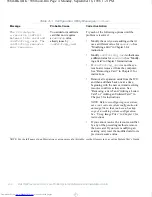
7-10
Dell OptiPlex Gs and Gs+ Low-Profile Systems Reference and Installation Guide
second partition of 500 megabytes (MB) (drive D). Hard-
disk drives must be partitioned this way because
MS-DOS–based operating systems (including Windows NT
when using a FAT16 file system) do not support drive
partitions larger than 2 GB.
To partition and logically format your hard-disk drive,
use the program(s) offered by your operating system.
For MS-DOS, use the fdisk and format commands to
perform these procedures. The fdisk and format com-
mands are described in the MS-DOS reference
documentation.
For OS/2, see the discussion on partitioning and logical
formatting in the documentation that came with the oper-
ating system.
For Windows NT, see the discussion on partitioning and
logical formatting in the documentation that came with
the operating system.
For the UNIX
®
operating system, refer to your UNIX
documentation.
I
nstalling SCSI Devices
To use SCSI devices in your Dell computer, you must
have a SCSI host adapter card, which comes with its own
SCSI cable. This cable can be used to attach a variety of
SCSI devices (hard-disk drives, tape drives, and so on).
The SCSI host adapter configures the devices attached to
it as one subsystem—not as independent devices.
Although SCSI devices are installed essentially the same
way as other devices, their configuration requirements
are different.
SCSI Configuration Guidelines
For details on configuring your SCSI subsystem, refer to
the documentation that came with your SCSI devices
and/or your host adapter card. The following subsections
offer some general guidelines.
SCSI ID Numbers
Each device attached to a SCSI host adapter card, as well
as the card itself, must have a unique SCSI identification
(SCSI ID) number from 0 to 7. When SCSI devices are
shipped from Dell, the default SCSI ID numbers are
assigned as follows:
•
A SCSI host adapter card is configured as SCSI ID 7
(the default ID for a host adapter card).
•
A SCSI tape drive or digital audio tape (DAT) drive
is configured as SCSI ID 6 (the default ID number
for a tape drive).
•
A SCSI CD-ROM drive is configured as SCSI ID 5.
•
SCSI hard-disk drives are usually configured as
SCSI ID 0 (the drive used to boot your system
should always be configured as SCSI ID 0).
NOTE: There is no requirement that SCSI ID numbers be
assigned sequentially or that devices be attached to the
cable in order by ID number.
SCSI Cable and SCSI Termination
The type of cabling you receive with your SCSI device
depends on whether you are installing an internal or
external SCSI device:
•
If you have an internal SCSI device, your system
supports a maximum of two internal SCSI devices—
one in the hard-disk drive bracket and one in the
5.25-inch drive bay—as shown in Figure 7-15.
CAUTION: If you format your hard-disk drive
under the OS/2 High Performance File System
(HPFS), you cannot reformat the drive for
MS-DOS without losing all HPFS data. See your
OS/2 documentation for details.
CAUTION: If you format your hard-disk drive
under the Windows NT File System (NTFS), you
cannot reformat the drive for MS-DOS without los-
ing all NTFS data. See your Windows NT
documentation for details.
93816BK0.BK : 93816c70.frm Page 10 Monday, September 16, 1996 1:21 PM
















































